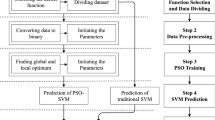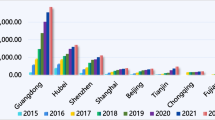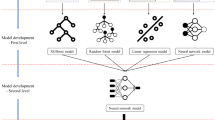Abstract
Carbon emission trading system is one of the important means for China to tackle climate warming and achieve the dual-carbon goals. However, due to the characteristics of the carbon emission trading prices, such as nonlinearity, instability, and complexity of predictor variables, the performance of existing prediction models is relatively poor. In order to solve the above problems, a prediction model considering the predictor variables of carbon emission trading prices is proposed in this paper. The proposed method first analyzes 18 predictor variables in six categories and Lasso is used to select predictor variables as inputs for the prediction model. Secondly, sliding time window technique is adopted to analyze the dynamics and trends in the carbon market. Then, differential evolution (DE) algorithm is utilized to improve the performance of support vector regression (SVR), where SVR is used as the prediction model for carbon emission trading prices. Finally, the carbon emission trading price is taken as a sample set in Hubei Province, together with the selected predictor variables, as input to the prediction model. The experimental results show that the proposed model obtains optimal results in three performance evaluation metrics, including root mean square error (RMSE), mean absolute error (MAE) and mean absolute percentage error (MAPE). Compared with the basic model, the results decreased by 1.6081, 1.4753 and 5.5418% respectively, which improved the prediction accuracy of the model. And the proposed model has also achieved better performance in predicting the prices of China’s carbon emissions trading market.







Similar content being viewed by others
Explore related subjects
Discover the latest articles, news and stories from top researchers in related subjects.References
Narassimhan E, Gallagher KS, Koester S, Alejo JR (2018) Carbon pricing in practice: a review of existing emissions trading systems. Clim Policy 18(8):967–991
Wu L, Zhu Q (2021) Impacts of the carbon emission trading system on China’s carbon emission peak: a new data-driven approach. Nat Hazards 107(3):2487–2515
Wang R (2010) Short-term electricity price forecasting based on grey system theory and time series analysis. IEEE, Chengdu, China, pp 1–4. https://doi.org/10.1109/APPEEC.2010.5448651
Liu H, Shi J (2013) Applying ARMA–GARCH approaches to forecasting short-term electricity prices. Energy Econ 37(may):152–166
Valipour M, Banihabib ME, Behbahani SMR (2013) Comparison of the ARMA, ARIMA, and the autoregressive artificial neural network models in forecasting the monthly inflow of DEZ dam reservoir. J Hydrol 476:433–441
Zhang H, Zhang S, Wang P, Qin Y, Wang H (2017) Forecasting of particulate matter time series using wavelet analysis and wavelet-ARMA/ARIMA model in Taiyuan, China. J Air Waste Manag Assoc 67(7):776–788
Zhang YJ, Yao T, He LY (2015) Forecasting crude oil market volatility: can the regime switching GARCH model beat the single-regime GARCH models? Int Rev Econ Finance 59
Yu Z, Sun T, Sun H, Yang F (2015) Research on combinational forecast models for the traffic flow. Math Probl Eng 2015(1):201686
Thenmozhi M, Sarath Chand G (2016) Forecasting stock returns based on information transmission across global markets using support vector machines. Neural Comput Appl 27(4):805–824
Zhang J, Teng Y, Chen W (2019) Support vector regression with modified firefly algorithm for stock price forecasting. Appl Intell
Sun H, Yu B, Amman H (2020) Forecasting financial returns volatility: a GARCH-SVR model. Comput Econ 55(2):451–471
Ge M, Junfeng Z, Jinfei W, Huiting H, Hongye W (2021) ARIMA-FSVR hybrid method for high-speed railway passenger traffic forecasting. Math Probl Eng 2021:1–5
Meng Z, Sun H, Wang X (2022) Forecasting energy consumption based on SVR and Markov model: a case study of china. Front Environ Sci 10:883711
Zhu B, Chevallier J, Zhu B, Chevallier J (2017) Carbon price forecasting with a hybrid ARIMA and least squares support vector machines methodology. In: Pricing and forecasting carbon markets: models and empirical analyses, pp 87–107
Tsai M-T, Kuo Y-T (2013) A forecasting system of carbon price in the carbon trading markets using artificial neural network. Int J Environ Sci Dev 4(2):163
Jiang L, Wu P (2015) International carbon market price forecasting using an integration model based on SVR. In: 2015 international conference on engineering management, engineering education and information technology. Atlantis Press, pp 303–308
Zhang J, Li D, Hao Y, Tan Z (2018) A hybrid model using signal processing technology, econometric models and neural network for carbon spot price forecasting. J Clean Prod 204:958–964
Sun W, Zhang C (2018) Analysis and forecasting of the carbon price using multi-resolution singular value decomposition and extreme learning machine optimized by adaptive whale optimization algorithm. Appl Energy 231:1354–1371
Huang Y, Dai X, Wang Q, Zhou D (2021) A hybrid model for carbon price forecasting using GARCH and long short-term memory network. Appl Energy 285:116485
Zhou J, Yu X, Yuan X (2018) Predicting the carbon price sequence in the Shenzhen emissions exchange using a multiscale ensemble forecasting model based on ensemble empirical mode decomposition. Energies 11(7):1907
Han M, Ding L, Zhao X, Kang W (2019) Forecasting carbon prices in the Shenzhen market, China: the role of mixed-frequency factors. Energy 171:69–76
Zhu J, Wu P, Chen H, Liu J, Zhou L (2019) Carbon price forecasting with variational mode decomposition and optimal combined model. Physica A 519:140–158
Ye P, Li Y, Siddik AB (2023) Forecasting the return of carbon price in the Chinese market based on an improved stacking ensemble algorithm. Energies 16(11):4520
Wang J, Zhuang Z (2023) A novel cluster based multi-index nonlinear ensemble framework for carbon price forecasting. Environ Dev Sustain 25(7):6225–6247
Liu J, Li X, Wang P, Chen H, Zhu J (2023) An interval-valued carbon price forecasting method based on web search data and social media sentiment. Environ Sci Pollut Res 30(42):95840–95859
Ji C-J, Hu Y-J, Tang B-J (2018) Research on carbon market price mechanism and influencing factors: a literature review. Nat Hazards 92:761–782
Lin B, Jia Z (2019) What are the main factors affecting carbon price in emission trading scheme? A case study in china. Sci Total Environ 654:525–534
Zhang X, Zhang C, Wei Z (2019) Carbon price forecasting based on multi-resolution singular value decomposition and extreme learning machine optimized by the moth-flame optimization algorithm considering energy and economic factors. Energies 12(22):4283
Sun W, Sun C, Li Z (2020) A hybrid carbon price forecasting model with external and internal influencing factors considered comprehensively: a case study from china. Pol J Environ Stud 29(5):3305–3316
Zeng S, Zhang H, Qu Y, Zeng B (2021) Study on price fluctuation and influencing factors of regional carbon emission trading in China under the background of high-quality economic development. Int. Energy J 21:201–211
Zhang S, Ji H, Tian M, Wang B (2022) High-dimensional nonlinear dependence and risk spillovers analysis between China’s carbon market and its major influence factors. Ann Oper Res. https://doi.org/10.1007/s10479-022-04770-9
Song X, Zhang W, Ge Z, Huang S, Huang Y, Xiong S (2022) A study of the influencing factors on the carbon emission trading price in china based on the improved gray relational analysis model. Sustainability 14(13):8002
Li J, Liu D (2023) Carbon price forecasting based on secondary decomposition and feature screening. Energy 278:127783
Liu YL, Zhang JJ, Fang Y (2023) The driving factors of China’s carbon prices: evidence from using ICEEMDAN-HC method and quantile regression. Financ Res Lett 54:103756
Cohen I, Huang Y, Chen J, Benesty J, Benesty J, Chen J, Huang Y, Cohen I (2009) Pearson correlation coefficient. In: Noise reduction in speech processing, Springer, Heidelberg, pp 37–40
Gu D, Huang J (2020) Multifractal detrended cross-correlation analysis of high-frequency stock series based on ensemble empirical mode decomposition. Fractals 28(02):2050035
Xie Y, Liu S, Fang H, Wang J (2020) Global autocorrelation test based on the Monte Carlo method and impacts of eliminating nonstationary components on the global autocorrelation test. Stoch Environ Res Risk Assess 34:1645–1658
Narula SC, Wellington JF (2007) Multiple criteria linear regression. Eur J Oper Res 181(2):767–772
Duan J, Soussen C, Brie D, Idier J, Wan M, Wang Y-P (2016) Generalized lasso with under-determined regularization matrices. Signal Process 127:239–246
Awad M, Khanna R, Awad M, Khanna R (2015) Support vector regression. In: Efficient learning machines. Theories, concepts, and applications for engineers and system designers, pp 67–80
Peng C, Che Z, Liao TW, Zhang Z (2023) Prediction using multi-objective slime mould algorithm optimized support vector regression model. Appl Soft Comput 145:110580
Li C, Yao W, Wang H, Jiang T, Zhang X (2023) Bayesian evolutionary optimization for crafting high-quality adversarial examples with limited query budget. Appl Soft Comput 142:110370
Ji C-J, Li X-Y, Hu Y-J, Wang X-Y, Tang B-J (2019) Research on carbon price in emissions trading scheme: a bibliometric analysis. Nat Hazards 99:1381–1396
Li H, Lei M (2018) The influencing factors of china carbon price: a study based on carbon trading market in Hubei Province. In: IOP conference series: earth and environmental science. IOP Publishing, vol 121, p 052073
Yin Y, Jiang Z, Liu Y, Yu Z (2019) Factors affecting carbon emission trading price: evidence from china. Emerg Mark Financ Trade 55(15):3433–3451
Ye J, Xue M (2021) Influences of sentiment from news articles on EU carbon prices. Energy Econ 101:105393
Ratner B (2009) The correlation coefficient: its values range between \(+1/-1\), or do they? J Target Meas Anal Mark 17(2):139–142
Author information
Authors and Affiliations
Corresponding author
Additional information
Publisher's Note
Springer Nature remains neutral with regard to jurisdictional claims in published maps and institutional affiliations.
Rights and permissions
Springer Nature or its licensor (e.g. a society or other partner) holds exclusive rights to this article under a publishing agreement with the author(s) or other rightsholder(s); author self-archiving of the accepted manuscript version of this article is solely governed by the terms of such publishing agreement and applicable law.
About this article
Cite this article
Jia, S., Tan, Z. & Li, C. Carbon prices forecasting based on sliding time window and improved support vector regression. Computing 107, 53 (2025). https://doi.org/10.1007/s00607-024-01404-9
Received:
Accepted:
Published:
DOI: https://doi.org/10.1007/s00607-024-01404-9




